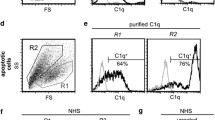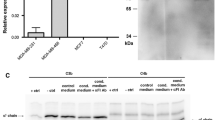Abstract
In a previous study, we found hypercomplementaemia in the sera of acute myeloid leukemia patients. In this study we show that the supernatants of mononuclear cells, derived from peripheral blood taken in the blastic phase, from patients with acute myeloid leukemia (CM-AML) increased thein vitro complement protein synthesis of HepG2 hepatocellular carcinoma cells. This effect of CM-AML was mediated by heat labile soluble factors and involved the synthesis of mRNA and protein. Inhibition experiments with anti-cytokine antibodies and immunoaffinity chromatography revealed that this effect of CM-AML is mostly mediated by IL-1 and IL-6.
Similar content being viewed by others
Abbreviations
- IL-1:
-
interleukin-l-beta
- IL-2:
-
intcrleukin-2
- IL-6:
-
Interleukin-6
- TNF:
-
tumor necrosis factor
- C2:
-
complement factor 2
- C3:
-
complement factor 3
- C4:
-
complement factor 4
- -INH:
-
1-esterase inhibitor
- AML:
-
acute myeloid leukemia
- CM-AML:
-
conditioned medium of mononuclear cells derived from the blood of a patient with AML
- CM-PBMNC:
-
conditioned medium of peripheral blood mononuclear cells derived from the blood of a healthy volunteer
References
Lichtenfeld JL, Wernik PH, Mardiney MR and Zureo RM: Abnormalities of complement and its components in patients with acute leukemia. Hodgkin’s disease and sarcoma. Cancer Res 36: 3678–3685, 1976.
Nishioka K, Kawamura K, Hirdyamd T, Kawashima T, Shimada K and Kgure M: The complement system in tumor immunity: significance of elevated levels of complement in tumor bearing hosts. Ann NY Acad Sei 276: 303–315, 1976.
Puday ÁT, Füst G and Csömör A: Serum complement levels in patients with cancer of the uterine cervix before and after radiation therapy. Neoplasma 27: 211–216, 1980.
Bach-Mortensen N, Osther K and Stroyer I: CL-esterase inactivators and C4 in malignant diseases. Lancet 2: 499–500, 1975.
Verhdrgen H, De Cock W, De Cree J MD and Verbruggen F: Increase of serum complement levels in cancer patients with progressing tumors. Cancer 38: 1608–1613. 1976.
Astrup J, Colstrup H and Frandsen B: Complement Cl -inactivator in the serum of patients with malignant disease. Acta Radiol Ther Phys Biol. 16. Fase 5: 394–400, 1977.
Do-Quang Minh, Czink E, Mód A, Füst G and Hollán SR: Serial complement measurements in patients with leukemia. Clin Lab Hematol 5: 23–24. 1983.
Gyapay G, Schmidt B, Válay M, Falus A, Anh-Tuan N, Pánya A, Kókai M, Ónody K, Mód A and Füst G: Effect of Conditioned Media of Acute Myeloid Blast Cells on Complement Synthesis by Cultured Human Cells of Monocyte and Hepatocyte Origin. Complement and Inflammation 8: 370–377, 1991.
Schmidt B, Gyapay G, Kramer J and Füst G: Complement Synthesis Regulating factors in the Conditioned Medium of Acute Myeloid Leukemia (AML) Blast Cells. Mol Immunol 30: (Suppl 1): 50, 1993.
Alper CA, Johnson AM, Birtch AG and Moore FD: Human C3: evidence for the liver as the primary site of synthesis. Science 163: 286, 1969.
Knowlrs BB, Howe CC and Aden DP: Human hepatocellular carcinoma cell lines secrete the major plasma proteins and Hepatitis surface antigen. Science 209: 497, 1983.
Kurzrock R, Kantarijan H, Wetzler M, Estroy Z, Estey E, Troutman-Worden K, Guterman JU and Talpaz M: Ubiquitous expression of cytokines in diverse leukemias of lymphoid and myeloid lineage. Exp Hematol 21: 80–85, 1993.
Griffun JD, Rambaldi A, Vellenga E, Young DC, Ostapovicz D and Cdnnistrd SA: Secretion of interleukin-l by acute myeloid leukemia cells in vitro induces endothelial cells to secrete colony stimulating factors. Blood 70: 218–21, 1987.
Lopez M, Maroc N, Kerangueyen F, Bardin F, Coureoul M, Lavezzi C, Birg F and Mannani P: Coexpression of the genes for interleukin 6 and its receptor without apparent involvement in the proliferation of acute myeloid leukemia cells. Exp Hematol 19: 797–803, 1991.
Cimino G, Amadori S, Cava MC, De Sanctis V, Petti MC, Di Gregorio AO, Sgaduri C, Vgna L, Cimino G and Mandelli F: Serum Interleukin-2 (IL-2). soluble IL-2 receptors and tumor necrosis factor-alpha levels are significantly increased in acute myeloid leukemia patients. Leukemia 5: 32–35, 1991.
Falus A, Rokita H, Wale, E, Brozik M, Hidvëgi T and Merétey K: Hormonal regulation of complement biosynthesis in human cell lines - II. Upregulation of the biosynthesis of complement components C3, factor B. and C1 inhibitor by interleukin-6 and interleukin-1 in human hepatoma cell line. Mol Immunol 27: 197–201, 1990.
Perlmutter DH, Dinarello CA, Punsal PI and Colten HR: Cachectin/tumor necrosis factor regulates hepatic acute-phase gene expression. J Clin Invest 78: 1349–1354, 1986.
Wagteveld AJ, Esselink MT, Limburg P, Hulie MR and Vellenga E: The effects of IL-1- and IL-4 on the proliferation and secretion of growth factors by acute myeloblastic leukemic cells. Leukemia 6: 1020–1024, 1992.
Estrov Z, Kurzrock R, Estey E, Wetzler M, Ferrdjoli A, Harris D, Blake M, Gutterman JU and Talpaz M: Inhibition of acute myelogenous leukemia blast proliferation by interleukin-1 (IL-1) receptor antagonist and soluble IL-1 receptors. Blood 79: 1938–1945, 1992.
Rambaldi A, Torcia M, Dinarello CA, Barbui T and Cozzoloni F: Modulation of cell proliferation and cytokine production in AML by recombinant interleukin-1 receptor antagonist. Leukemia (Suppl 2): S10–12, 1993.
Hodng T, Human A, Goncalves O, Wong GG and Clark SC: Interleukin-6 enhances growth factor-dependent proliferation of the blast cells of acute myeloblastic leukemia. Blood 72: 823–26, 1988.
Füst G, Schmidt B and Vrga L: Clinical significance of hypereomplementemia. In: New aspects of complement structure and function. (Erdei A. Ed.). RG. Landes Company. Austin 1994.
Author information
Authors and Affiliations
Rights and permissions
About this article
Cite this article
Schmidt, B., Válay, M., Nahajevszky, S. et al. Complement synthesis influencing factors produced by acute myeloid leukemia blast cells. Pathol. Oncol. Res. 1, 54–59 (1995). https://doi.org/10.1007/BF02893584
Received:
Accepted:
Issue Date:
DOI: https://doi.org/10.1007/BF02893584




